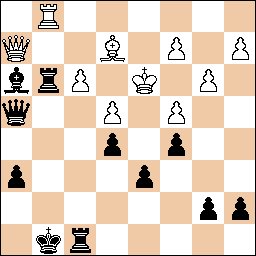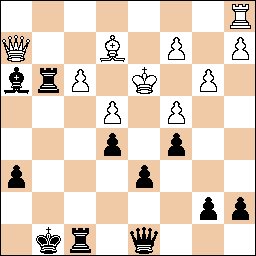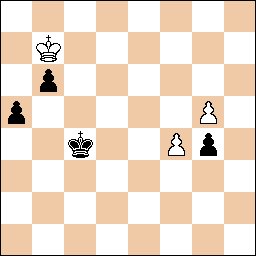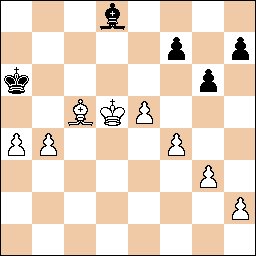Friday, April 28, 2006
Still Working on Circle 5
The problem solving is going along fairly well. I hope to have some extra time this weekend to review some annotated games. Speaking a which I wanted to post something about Varuzhan Akobian. Like many players struggling to improve, I have been following his instructional game reviews on Chess.FM, gleaning as much as I could through the rapid, heavily Eastern-European tones. Repeatedly I have guided my mouse to the pause button, reflected on what he was saying, and concluded that each idea was reasonable.
His approach seems simple, solid, and logical. He plays well-known openings, ones that lead towards a natural middlegame that even I can understand. I find this perplexing, as he is a GM. Long ago I incorrectly suspected that he only showed his simpler games on Chess.FM for the sake of the beginning and intermediate viewers, but since then I have seem him play on the ICC and that is his style. There are countless lower rated experts and masters who I cannot follow worth a darn. This seems to be a bit of a puzzle. Anyway, I think that compared with other GMs, Varuzhan's approach is closer to what a intermediate player could realistically hope to emulate.
His approach seems simple, solid, and logical. He plays well-known openings, ones that lead towards a natural middlegame that even I can understand. I find this perplexing, as he is a GM. Long ago I incorrectly suspected that he only showed his simpler games on Chess.FM for the sake of the beginning and intermediate viewers, but since then I have seem him play on the ICC and that is his style. There are countless lower rated experts and masters who I cannot follow worth a darn. This seems to be a bit of a puzzle. Anyway, I think that compared with other GMs, Varuzhan's approach is closer to what a intermediate player could realistically hope to emulate.
-=-=-=-=-
TCT Results | Circle 1 | Circle 2 | Circle 3 | Circle 4 | Circle 5 | Circle 6 | Circle 7 |
| Step 1 | 97% | 99% | 99% | 100%r | |||
| Step 2 | 93% | 96% | 95% | 97% | 96% | 99% | 100% |
| Step 3 | 93% | 97% | 97% | 96% | 96% | 98% | 99% |
| Step 4 | 80% | 86% | 90% | 92% | 89% | ||
| Step 5 | 74% | 77% | 83% | 87% | 89%* |
Saturday, April 22, 2006
Update
The mixture schedule is still going well. It is difficult to keep everything going on that list each week. I have been lax about reviewing openings, which as an activity that has paid off in the past. I hardly have time to read blogs, too.
A part of what I rusty on last month was checkmate problems. Since then I have made it a point to go through both the Polgar 5334 brick and the 1001 Reinfeld book, doing 6 or 18 mate in two problems several days a week in addition to TCT. It has helped tremendously, and now I enjoy a 30% faster solving speed on average (compared to what they were when I started these circles). I credit pattern recognition recognition, as my calculation speed and accuracy unfortunately seem about the same. The gut feeling I used to get that pieces were being pulled one way or another is pretty much completely gone, but I still seem to benefit from the approach of ruling out the suicidal-looking moves first.
The speed increase coincides my experience in recent standard games. I still am at 1500, and as easy as it was to get to that rating, it is extremely tough to get higher. I haven't beaten any 1700 + players in standard time controls on the ICC. I know that it is premature to make any conclusions about the circles, as my idea was to play/post-mortem 100 standard games after the circles before passing judgment. I do want to say for the record I am playing the kind of game I played last year but faster. Obviously circle-time will become game-time later. Still, I am concerned that I haven't truly addressed my middlegame calculation weakness due to focusing on TCT; I bet CT-Art users are forming better depth calculation skills. Ah, well, I guess it's better to attempt walking before running.
Referring back to checkmate problems, once in awhile I disassemble one of these positions, putting it in terms of simultaneous advantage. I think I have been underestimating how complex these problems are, as even in the easy mate in two problems that there typically is alot going on in the position. Often if you take away even one little advantage, it no longer is checkmate. This has led me to a deeper appreciation of what it will take to get through 5334, cover to cover. For those of you who completed it, my hat is off to you!
-=-=-=-=-
A part of what I rusty on last month was checkmate problems. Since then I have made it a point to go through both the Polgar 5334 brick and the 1001 Reinfeld book, doing 6 or 18 mate in two problems several days a week in addition to TCT. It has helped tremendously, and now I enjoy a 30% faster solving speed on average (compared to what they were when I started these circles). I credit pattern recognition recognition, as my calculation speed and accuracy unfortunately seem about the same. The gut feeling I used to get that pieces were being pulled one way or another is pretty much completely gone, but I still seem to benefit from the approach of ruling out the suicidal-looking moves first.
The speed increase coincides my experience in recent standard games. I still am at 1500, and as easy as it was to get to that rating, it is extremely tough to get higher. I haven't beaten any 1700 + players in standard time controls on the ICC. I know that it is premature to make any conclusions about the circles, as my idea was to play/post-mortem 100 standard games after the circles before passing judgment. I do want to say for the record I am playing the kind of game I played last year but faster. Obviously circle-time will become game-time later. Still, I am concerned that I haven't truly addressed my middlegame calculation weakness due to focusing on TCT; I bet CT-Art users are forming better depth calculation skills. Ah, well, I guess it's better to attempt walking before running.
Referring back to checkmate problems, once in awhile I disassemble one of these positions, putting it in terms of simultaneous advantage. I think I have been underestimating how complex these problems are, as even in the easy mate in two problems that there typically is alot going on in the position. Often if you take away even one little advantage, it no longer is checkmate. This has led me to a deeper appreciation of what it will take to get through 5334, cover to cover. For those of you who completed it, my hat is off to you!
-=-=-=-=-
TCT Results | Circle 1 | Circle 2 | Circle 3 | Circle 4 | Circle 5 | Circle 6 | Circle 7 |
| Step 1 | 97% | 99% | 99% | 100%r | |||
| Step 2 | 93% | 96% | 95% | 97% | 96% | 99% | 100% |
| Step 3 | 93% | 97% | 97% | 96% | 96% | 98% | 99% |
| Step 4 | 80% | 86% | 90% | 92% | 89% | ||
| Step 5 | 74% | 77% | 83% | 87% | 90%* |
Saturday, April 15, 2006
A Couple More
TCT Step 5 is hard but I am chipping away at it. I even had several groups of problems > 95%, which is somewhat misleading. These are quite challenging for me.


Rfxf3+ 32. Bxf3 {Kd2?! Qg5+ leads to Rxg1+} Bf1+! {discovers an attack on White's Queen}
Rfxf3+ {either Rook can sacrifice first and it works out the same} 32. Bxf3 {Kd2?! elicits Qg5+ which pushes the King back to his first rank, setting up the skewer Rg1+} Rxf3+ 33. Ke2 Bg4! {the hanging Bishop can be pinned but the King is under a discovered attack. Now 34. Qg2 is met by Rg3+, and 34. Rg1 is met with Qg5 which in turn threatens to once again Black can use his Rook to chase the Queen with a discovered check or, depending on what White does, even play Qe3+ Kd1 leaving White with a lost position. Moving the King back doesn't work either because of similar discoveries and the threat of Qa5 attacking e1.}
The whole game if anyone was curious, mistakes and all:
-=-=-=-=-
I have a ever increasing list of positions that I need to work on if I ever hope to improve. These are positions that I either did not understand or did not play correctly but can understand later. Here is a pair of puzzle-like situations that I recently added, and the first one is a beauty:
Black to Move (both)


Rfxf3+ 32. Bxf3 {Kd2?! Qg5+ leads to Rxg1+} Bf1+! {discovers an attack on White's Queen}
Rfxf3+ {either Rook can sacrifice first and it works out the same} 32. Bxf3 {Kd2?! elicits Qg5+ which pushes the King back to his first rank, setting up the skewer Rg1+} Rxf3+ 33. Ke2 Bg4! {the hanging Bishop can be pinned but the King is under a discovered attack. Now 34. Qg2 is met by Rg3+, and 34. Rg1 is met with Qg5 which in turn threatens to once again Black can use his Rook to chase the Queen with a discovered check or, depending on what White does, even play Qe3+ Kd1 leaving White with a lost position. Moving the King back doesn't work either because of similar discoveries and the threat of Qa5 attacking e1.}
The whole game if anyone was curious, mistakes and all:
1.e4 e5 2.Nf3 Nf6 3.Nc3 Bb4 4.Bc4 Bxc3 5.dxc3 O-O 6.Bg5 d6 7.Nd2 Be6 8.Bd3 Nbd7 9.h3
h6 10.Bh4 c5 11.b3 Qa5 12.c4 Nh7 13.O-O f5 14.f3 g5 15.Bf2 f4 16.g4 fxg3 17.Bxg3
Bxh3 18.Rf2 Nhf6 19.Nf1 Rf7 20.Ne3 Nh5 21.Bh2 Raf8 22.Nd5 Qd8 23.Be2 Ndf6 24.Ne3
Nf4 25.Bxf4 gxf4 26.Rh2 Rg7+ 27.Kf2 fxe3+ 28.Kxe3 Rg3 29.Qh1 Ng4+ 30.Kd3 Nxh2 31.Qxh2
Qh4 32.Rg1 Rxg1 33.Qxg1+ Kh7 34.Qe3 Qe1 35.a4 Bf1 36.Bxf1 Qxf1+ 37.Kc3 Rxf3 38.Qxf3
{White resigns} 0-1
-=-=-=-=-
TCT Results | Circle 1 | Circle 2 | Circle 3 | Circle 4 | Circle 5 | Circle 6 | Circle 7 |
| Step 1 | 97% | 99% | 99% | 100%r | |||
| Step 2 | 93% | 96% | 95% | 97% | 96% | 99% | 100% |
| Step 3 | 93% | 97% | 97% | 96% | 96% | 98% | 99% |
| Step 4 | 80% | 86% | 90% | 92% | 89% | ||
| Step 5 | 74% | 77% | 83% | 87% | 93%* |
Thursday, April 13, 2006
Plenty to Work On
I started Step 5 of TCT - it's challenging. I haven't focused on pawn breakthrough tactics for awhile and it shows. I really worked on those heavily over a year ago... something else to review I guess. I also worked a little in the old 1001 checkmate book and ran into a wall on #399. Thud. I just don't have an instinct for that type of position. Solving longer mate problems seems like its own thing, as my work on 2 and 3 move mates does not seem to help much for mate in 6 or 7.
-=-=-=-=-
This happened in a blitz game where I was White. If you forget about the huge winning advantage and just focus on what's the strongest way to finish this one off, you probably will see what I missed. With the subtlety of a bulldozer I pushed with e6, simply clearing the way for the White King to go munch on the Black Kingside pawns. I suppose there was time-pressure in that move. The point is that I missed the beautiful move Kc6. Kc6 immobilizes Black's King and leaves Black's dark-squared Bishop with no good moves. Black can push the h pawn, but so can White, square for square. If Black tries to push his g or f pawn, White can capture it with impunity because the Black Bishop is stuck preventing Bb6 followed by b5#. Nice, eh?
-=-=-=-=-
White to Move
This happened in a blitz game where I was White. If you forget about the huge winning advantage and just focus on what's the strongest way to finish this one off, you probably will see what I missed. With the subtlety of a bulldozer I pushed with e6, simply clearing the way for the White King to go munch on the Black Kingside pawns. I suppose there was time-pressure in that move. The point is that I missed the beautiful move Kc6. Kc6 immobilizes Black's King and leaves Black's dark-squared Bishop with no good moves. Black can push the h pawn, but so can White, square for square. If Black tries to push his g or f pawn, White can capture it with impunity because the Black Bishop is stuck preventing Bb6 followed by b5#. Nice, eh?
-=-=-=-=-
TCT Results | Circle 1 | Circle 2 | Circle 3 | Circle 4 | Circle 5 | Circle 6 | Circle 7 |
| Step 1 | 97% | 99% | 99% | 100%r | |||
| Step 2 | 93% | 96% | 95% | 97% | 96% | 99% | 100% |
| Step 3 | 93% | 97% | 97% | 96% | 96% | 98% | 99% |
| Step 4 | 80% | 86% | 90% | 92% | 89% | ||
| Step 5 | 74% | 77% | 83% | 87% | 89%* |
Sunday, April 09, 2006
Circle 5, Step 4 Complete
I spent some extra time this weekend to get to the end. I am really getting the sense that I will need circle 8 or at least some review on the ~500 problems in this Step.
I want to mention a funny thing I saw on the ICC. I was observing two 2100+ players in a 15/0 game. It was a perpetual draw position that Black (who was behind a pawn) had gotten into, but he left that perpetual to go into another type of perpetual where if his opponent defended wrong, it would turn into checkmate. With 4 minutes left, White got into a "quick move" mode, moved into this other perpetual position with chances, and then failed to see that Black blundered into a mate in 5 and achieved his draw. DOH!
This type of thing is fundamentally something that I never think of; when I am down materially and see a perpetual, I will go for it and offer a draw. At first I thought not heading towards the unambiguous draw would be ungentlemanly, but I now think that it is demanding that your opponent bring his "A" defense to the board.
Ok, it is devious too :-).
I want to mention a funny thing I saw on the ICC. I was observing two 2100+ players in a 15/0 game. It was a perpetual draw position that Black (who was behind a pawn) had gotten into, but he left that perpetual to go into another type of perpetual where if his opponent defended wrong, it would turn into checkmate. With 4 minutes left, White got into a "quick move" mode, moved into this other perpetual position with chances, and then failed to see that Black blundered into a mate in 5 and achieved his draw. DOH!
This type of thing is fundamentally something that I never think of; when I am down materially and see a perpetual, I will go for it and offer a draw. At first I thought not heading towards the unambiguous draw would be ungentlemanly, but I now think that it is demanding that your opponent bring his "A" defense to the board.
Ok, it is devious too :-).
-=-=-=-=-
TCT Results | Circle 1 | Circle 2 | Circle 3 | Circle 4 | Circle 5 | Circle 6 | Circle 7 |
| Step 1 | 97% | 99% | 99% | 100%r | |||
| Step 2 | 93% | 96% | 95% | 97% | 96% | 99% | 100% |
| Step 3 | 93% | 97% | 97% | 96% | 96% | 98% | 99% |
| Step 4 | 80% | 86% | 90% | 92% | 89% | ||
| Step 5 | 74% | 77% | 83% | 87% |
Sunday, April 02, 2006
He Who Promotes Last...
... laughs last?!

Here is a neat little position that came up in a blitz game. It starts out with Black's King at the corner of the square of the passed c pawn. Can Black win, or is this just a draw?
.....
....
...
..
.
It turns out yes, he can, as long as he is willing to sacrifice a pawn and not get overly upset that White gets to promote first: 50...Kg4! 51. c6 h3+ 52. Kg1 (no other square is better, and f1and then e1 opens the way for both Black pawns to promote) Kf3 53. c7 h2+ 54. Kh1 Kf2 55. c8=Q g2+ 56. Kxh2 g1=Q+ 57. Kh3 Qg3# 0-1
I seem to be reorganizing how I think about positions. This is my guess why I am scoring clearly worse this circle than last time around. I find that I am going through problems more slowly, turning them around a little differently now. Another thing I notice is that it's a little bit easier to calculate bad variations and reason them out.
I just finished the "Elimination of the Defense" section in TCT, Step 4. Although I think the problems are good in this section, it is kind of weak in its organization. They use the themes of threatening and capturing a defender, and they even show capturing a indirectly defending piece, which I thought was quite instructive. Unfortunately, other themes are thrown in, like positions where your not beating up on defense but rather achieving material gains via forks or sacrifices like decoy and deflection. I just organize information differently.
Black to Move

Here is a neat little position that came up in a blitz game. It starts out with Black's King at the corner of the square of the passed c pawn. Can Black win, or is this just a draw?
.....
....
...
..
.
It turns out yes, he can, as long as he is willing to sacrifice a pawn and not get overly upset that White gets to promote first: 50...Kg4! 51. c6 h3+ 52. Kg1 (no other square is better, and f1and then e1 opens the way for both Black pawns to promote) Kf3 53. c7 h2+ 54. Kh1 Kf2 55. c8=Q g2+ 56. Kxh2 g1=Q+ 57. Kh3 Qg3# 0-1
-=-=-=-=-
I seem to be reorganizing how I think about positions. This is my guess why I am scoring clearly worse this circle than last time around. I find that I am going through problems more slowly, turning them around a little differently now. Another thing I notice is that it's a little bit easier to calculate bad variations and reason them out.
I just finished the "Elimination of the Defense" section in TCT, Step 4. Although I think the problems are good in this section, it is kind of weak in its organization. They use the themes of threatening and capturing a defender, and they even show capturing a indirectly defending piece, which I thought was quite instructive. Unfortunately, other themes are thrown in, like positions where your not beating up on defense but rather achieving material gains via forks or sacrifices like decoy and deflection. I just organize information differently.
-=-=-=-=-
TCT Results | Circle 1 | Circle 2 | Circle 3 | Circle 4 | Circle 5 | Circle 6 | Circle 7 |
| Step 1 | 97% | 99% | 99% | 100%r | |||
| Step 2 | 93% | 96% | 95% | 97% | 96% | 99% | 100% |
| Step 3 | 93% | 97% | 97% | 96% | 96% | 98% | 99% |
| Step 4 | 80% | 86% | 90% | 92% | 88%* | ||
| Step 5 | 74% | 77% | 83% | 87% |
Saturday, April 01, 2006
Rolling Along
The new schedule is working out better. I must still be feeling a bit lazy, and I seem almost resistant to reviewing the Queen fork/pin circle drills and openings. It's as if I want chess to somehow play on its own. I realize how absolutely ridiculous that is of course, but apparently I have a wishful thinking brain part that cannot help itself.

There are several bumps along the TCT Step 4 path, but none so difficult for me as this one. This pothole has to be one the most forcing, least ambiguous problem in Step 4 (once I you know the answer that is). Still, seeing it the fifth time around its clear that I just don't think this way. Not yet, at least. The answer is a forcing Rook check and sacrifice: Rc6+ Kh7 Rc5! threatening mate if Black takes the a7 pawn, or similarly Rc6+ Kh5 Rc5+! forking the King and Rook. Either way the a-pawn promotes, or worse things occur.
-=-=-=-=-
-=-=-=-=-
White to Move
White to Move
Tasc Chess Tutor: Step 4, 12a #4

There are several bumps along the TCT Step 4 path, but none so difficult for me as this one. This pothole has to be one the most forcing, least ambiguous problem in Step 4 (once I you know the answer that is). Still, seeing it the fifth time around its clear that I just don't think this way. Not yet, at least. The answer is a forcing Rook check and sacrifice: Rc6+ Kh7 Rc5! threatening mate if Black takes the a7 pawn, or similarly Rc6+ Kh5 Rc5+! forking the King and Rook. Either way the a-pawn promotes, or worse things occur.
-=-=-=-=-
TCT Results | Circle 1 | Circle 2 | Circle 3 | Circle 4 | Circle 5 | Circle 6 | Circle 7 |
| Step 1 | 97% | 99% | 99% | 100%r | |||
| Step 2 | 93% | 96% | 95% | 97% | 96% | 99% | 100% |
| Step 3 | 93% | 97% | 97% | 96% | 96% | 98% | 99% |
| Step 4 | 80% | 86% | 90% | 92% | 87%* | ||
| Step 5 | 74% | 77% | 83% | 87% |

